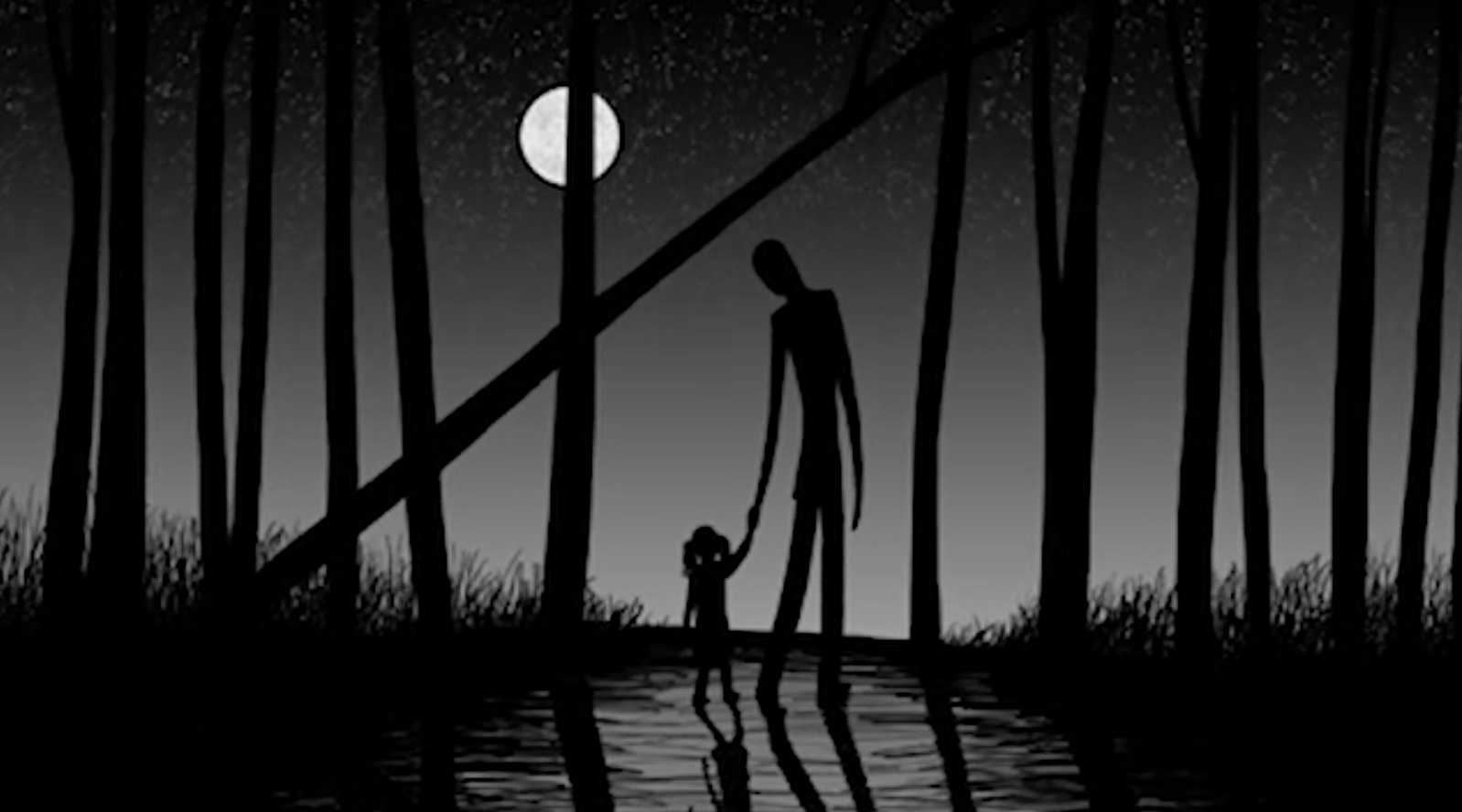The frightening power of the Slenderman
A new HBO documentary explores how an imaginary internet spook drove two pre-teens to near-murder

On the morning of May 31, 2014, in Waukesha, Wisconsin, a 12-year-old girl covered in blood crawled from the woods after being stabbed 19 times and left for dead by her "best friend" and another classmate.
The vicious attack, carried out by pre-teens Morgan Geyser and Anissa Weier, had been months in the making, and the unbelievable motive behind it reverberated from neighborhoods to newsrooms around the world: A mysterious (and obviously imaginary) bogeyman called "Slenderman," created and popularized on the internet, had inspired two sixth-graders to kill in his name.
As the now-teenaged defendants await trial in Wisconsin's adult court system later this summer, filmmaker Irene Taylor Brodsky's absorbing new documentary, Beware the Slenderman, which debuted on HBO Monday night, illuminates and examines the range of factors that led to the conception and commission of this shocking crime.
The Week
Escape your echo chamber. Get the facts behind the news, plus analysis from multiple perspectives.

Sign up for The Week's Free Newsletters
From our morning news briefing to a weekly Good News Newsletter, get the best of The Week delivered directly to your inbox.
From our morning news briefing to a weekly Good News Newsletter, get the best of The Week delivered directly to your inbox.
Slenderman was born on the internet in 2009. He is a faceless, strangely tall, black suited humanoid who quickly became an icon of macabre digital folklore. His eerie likeness has inspired rafts of fan fiction, artwork, and YouTube serials worldwide. He is often depicted stalking and abducting children at playgrounds or in the woods.
For numerous reasons that come to light in the documentary, Geyser and Weier not only believed the Slenderman was real, but that he would kill their families unless they killed for him. It is extraordinary that their Slenderman obsession got that far — but illustrative of the all-too-real power of imagined evils to spread like a virus in our digital age.
Their victim's survival teetered on miraculous, as one knife wound came within a millimeter of a major artery and certain death; and while 12-year-old Payton Leutner lay hospitalized in the week that followed, news of the attack spurred a wide strain of anxiety over the dangers of children plunging into the dark reaches of the internet. Among those inspired to investigate this disturbing story was filmmaker Irene Taylor Brodsky.
"I'm a parent, and I have kids around the age that these girls were when they were coming up with this plan," says Taylor Brodsky. "I think there's a lot of macabre material that is perfectly healthy for kids and adults to rummage through. But I do think that I'm acutely aware of the way my children are digesting it, and I think it's very different from the way you or I digest it. So I think the issue is not so much whether or not they should be rummaging through that stuff online, rummaging through Slenderman, but about the amount (of time spent) and how they're processing it, and just being aware of that."
A free daily email with the biggest news stories of the day – and the best features from TheWeek.com
While the pitfalls of 24/7 connectivity and issues of personal and parental discretion are regularly invoked, the drama of Beware the Slenderman spikes during chilling confessional footage of Geyser and Weier softly explaining the role of Slenderman in their lives and how they went about the attack. But it's the torment displayed by their parents (captured in stretches of candid, heart-rending conversations) that endure the most.
"These kids had underlying psychological issues their parents didn't know about, and those were probably the most dangerous factors here," says Taylor Brodsky. "Both the Weiers and the Geysers have additional children, and I have witnessed the way they interact with their children: They are very good parents. Did they know that the girls were interested in Slenderman? Yes. Did they know that the girls were spending a lot of time together? Yes. But I don't think that should raise an alarm bell for parents who are doing a good job."
"I feel sad for them — and I know they feel badly about it and think about it every day. The pain they must be feeling, that they could have done something, that they could've seen this [coming]; it must horrify them every day."
An ocean of fan-generated material on Slenderman resides online, and while a healthy portion might qualify as innocuously spooky, there are certainly a fraction of entries that are heinous and just plain evil. Exactly what caliber of Slenderman content the girls were consuming has yet to be divulged, but the violent nature of their crime suggests they were dwelling in treacherous territory.
"As for some of the more distasteful stories out there about Slenderman, I personally wish they weren't there, because I just don't need any more of that smut in my life, but this is what we bargained for," said Taylor Brodsky. "We created the internet, and now we're all awash in it. So I think we just have to think our way out of this mess, you know? We have to figure out how to create better defenses, not just for children, but for adults who have problems managing the internet, and managing the content they find on the internet. It interferes with people's lives. It interferes with people's relationships. It contributes to menacing behavior. We just have to talk about it… that's what I do with my kids. I haven't shown my children this film, but someday I will. They know who Slenderman is, and they know what the problem, what the incident was — and we talk about it at the dinner table a lot. And I feel like for now, I don't know if it's the best I can do, but it's one important thing I can do, is just keep the dialogue going."
Geyser and Weier have pled not guilty by reason of mental disease to attempted homicide charges after the Wisconsin court of appeals upheld a lower court's decision to try the pair as adults last July. They will be tried separately. You can learn more about their story at New York.
Russ Espinoza is an entertainment correspondent at TheWeek.com. His work has appeared in The Austin Chronicle, Austin Monthly, and 5280 Magazine.
-
 Political cartoons for November 27
Political cartoons for November 27Cartoons Thursday's political cartoons include giving thanks, speaking American, and more
-
 We Did OK, Kid: Anthony Hopkins’ candid memoir is a ‘page-turner’
We Did OK, Kid: Anthony Hopkins’ candid memoir is a ‘page-turner’The Week Recommends The 87-year-old recounts his journey from ‘hopeless’ student to Oscar-winning actor
-
 The Mushroom Tapes: a compelling deep dive into the trial that gripped Australia
The Mushroom Tapes: a compelling deep dive into the trial that gripped AustraliaThe Week Recommends Acclaimed authors team up for a ‘sensitive and insightful’ examination of what led a seemingly ordinary woman to poison four people
-
 A long weekend in Zürich
A long weekend in ZürichThe Week Recommends The vibrant Swiss city is far more than just a banking hub
-
 Walter Isaacson's 'Elon Musk' can 'scarcely contain its subject'
Walter Isaacson's 'Elon Musk' can 'scarcely contain its subject'The latest biography on the elusive tech mogul is causing a stir among critics
-
 Welcome to the new TheWeek.com!
Welcome to the new TheWeek.com!The Explainer Please allow us to reintroduce ourselves
-
 Late night hosts lightly try to square the GOP's Liz Cheney purge with its avowed hatred of 'cancel culture'
Late night hosts lightly try to square the GOP's Liz Cheney purge with its avowed hatred of 'cancel culture'Speed Read
-
 Late night hosts survey the creative ways America is encouraging COVID-19 vaccinations, cure 'Foxitis'
Late night hosts survey the creative ways America is encouraging COVID-19 vaccinations, cure 'Foxitis'Speed Read
-
 The Daily Show's Trevor Noah carefully steps through the Israel-Palestine minefield to an 'honest question'
The Daily Show's Trevor Noah carefully steps through the Israel-Palestine minefield to an 'honest question'Speed Read
-
 Late night hosts roast Medina Spirit's juicing scandal, 'cancel culture,' and Trump calling a horse a 'junky'
Late night hosts roast Medina Spirit's juicing scandal, 'cancel culture,' and Trump calling a horse a 'junky'Speed Read
-
 John Oliver tries to explain Black hair to fellow white people
John Oliver tries to explain Black hair to fellow white peopleSpeed Read